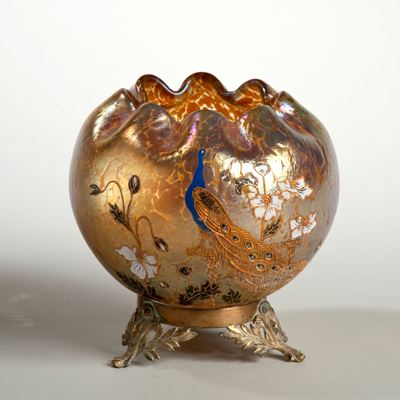Until the mid-nineteenth century, this fascinating optical light effect could only be seen in nature. About that time, archeologists began unearthing antique glass that had become iridescent from the effects of minerals, metals, and salts in the soil in which it had been buried for centuries. The newly discovered iridized antique glass inspired the premier decorative art
studios of the West, including
Louis Comfort Tiffany’s firm in the United States and Glasfabrik
Johann Loetz Witwe in Europe. Chemical techniques using the same elements found in soil made it possible for leading artists of the period to develop variations of this shimmering surface. Glass with an iridescent appearance is sometimes created by adding metallic materials to the primary ingredients of glass. Iridescence can also be achieved by spraying an object’s surface with stannous or lead chloride before heating it in an oxygen-deprived atmosphere. This installation is a showcase of diverse works, including not only lustrous art glass from Loetz (Bohemia) and Tiffany Studios (New York City), but ceramics and enamels from
Rookwood Pottery (Cincinnati), S. A.
Weller Pottery (Zanesville, Ohio), Robert Hanke (Bohemia),
Camille Fauré (France), and others. These firms and designers successfully produced supremely elegant and riveting art with iridescent rainbow colors on par with nature. Although interest in iridescence waned after World War I, it has never died.




